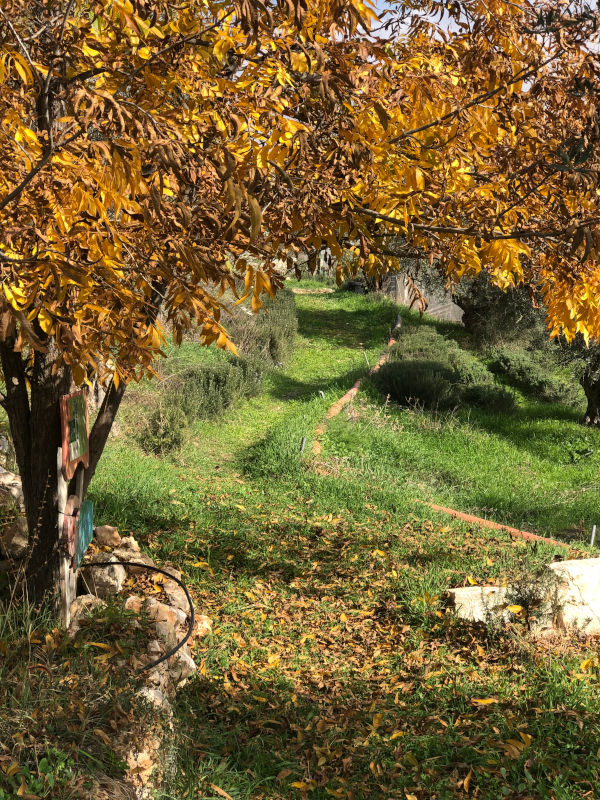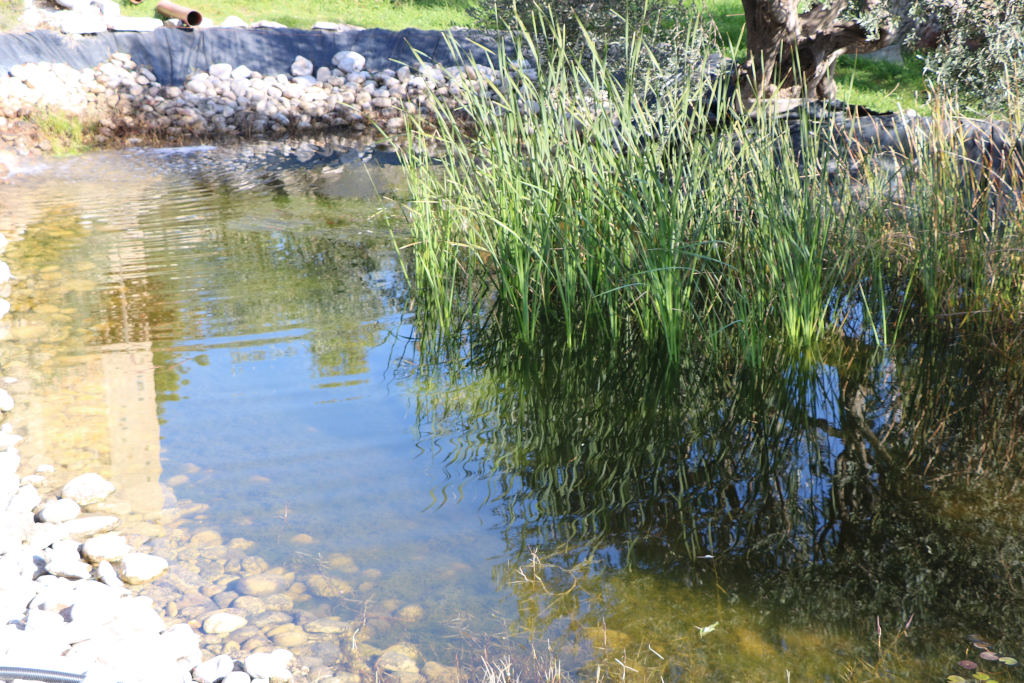Botanical Garden
The Botanical Garden at the Palestine Institute for Biodiversity and Sustainability (PIBS) in Bethlehem University is a place to study and conserve the plants and wildlife of Palestine. It is a member of the largest botanic garden network Botanic Gardens Conservation International since 2019. The Garden continued to develop, with more species added (now totalling some 412 plant species, belonging to 80 families, with 79 rare species, three parasitic species, and seven invasive species being combatted). Our ex situ conservation program refocused on two endangered groups in 2022: irises and orchids. We have six iris species and 19 orchid species in the program. Currently, more species are being added through collections from our region. The Botanical Garden' s mission as a garden fit vis-à-vis with PIBS' mission of preserving the natural and cultural heritage of Palestine by research, education, and conservation measures (In-situ and Ex-situ).

Importance of the garden
Despit its very small area (12 dunams) the botanic garden is a miniature reflection of the Palestinian unique flora and serves to raise awareness about the wonderful rich biodiversity at the intersection of three continents, as well as being a cradle of agriculture (see ethnography exhibition). The displays and exhibitions will orient visitors towards the necessity to develop and implement behaviors that aim for sustainable interaction between humans and their surrounding environments.

Main Goals of the Botanical Garden
1) Research: study the floral diversity in Palestine and their habitats with the aim of protection. Via field work, acquired knowledge, books, database and collected samples will raise the level of applied scientific research. 2) Conserving rare and threatened species of plants found in our Palestinian environment by in situ and ex situ conservation: via responsible propagation of the rare and threatened species in the garden and re-introduction of the successfully propagated species into their restored native habitats (combination of in-situ and ex-situ measures). 3) Providing visitors, researchers, and decision makers information on plant diversity in our Palestinian environment. 4) Education: via increasing awareness of human influence upon biodiversity and supporting responsible interaction with the surrounding environment. This is done through a set of educational models that aim to create a sustainable environment enriched in practices that preserve biodiversity and linked to Palestinian cultural heritage. 5) Building and indexing an electronic database for plant species in our Palestinian environment. 6) Developing the botanical garden as an oasis of knowledge and tranquility in an area known for conflict and increased urbanization. 7) Creating a center for researchers and those interested in plants in our Palestinian environment

Eco Pond
The pond works to create aqua biodiversity in the botanical garden in order to increase its biodiversity and attract the living creatures to it. This includes 49 species of birds observed in the garden. It was built in 2014 with the aim of attracting living creatures, including migratory birds, to be studied while they are around the pond. Many organisms have been introduced to the pond, as three species of frogs, 4 species of dragonflies, 4 species of freshwater snails, fish, crabs, and water turtles, in addition to algae and aquatic plants present in the water.
Objectives
1) Create aquatic biodiversity that complements the biodiversity found in the botanical garden 2) Educating visitors about the biodiversity and environmental balance in Palestine 3) Preserving some species by introducing them to the ecosystem in the pond 4) Providing a research aspect about the existing biodiversity and its interactions with each other in the pond and with the biodiversity in the garden
Community Garden
Shrinking land and water resources coupled with a fast population growth adds significant pressure on the local people and environment in Palestine. The pressures are great and may only increase in the next few years, and we do know that directing energy to positive ventures helps in moving towards community building. The Bethlehem district suffers from being very much urbanized and its 220,000 residents having few options, as the tourism economy is poor and open land is decreasing. Many growing up in urban areas now have little knowledge of their food sources, farming practices, importance of organic agriculture, and environmental issues around economic growth (a green economy). Thus, in brief, the community requires sustainable living conditions and knowledge about methods to improve their lives and livelihood (e.g. a healthy environment). The community garden is a section of our botanical garden that allows 30 families to cultivate and benefit from its productivity in harmony between wild plants, living organisms and agricultural crops.
Exploration Playground
Taking inspiration from nature and using ideas seen in other successful playgrounds using recycled and natural material, we proceeded to rehabilitate and develop a section of the Botanical Garden into an interactive exploration playground/children’s garden. The recent phenomenon of children’s gardens – both the landscape design and the educational play activities that are integral to their implementation – is based on the key concepts and research that demonstrate how children learn through play and provide strong evidence that outdoor play experiences in natural settings are essential components for building knowledge in many fields, as well as personal skills. It is also evident that spending time outdoors can be vital for mental and emotional healing for children experiencing trauma, violence, deprivation, and insecurity, as the case in Palestine.
Goals of the playground
1) Create a responsible interaction between society and the surrounding environment 2) Create a sustainable environmental awareness 3) Linking Children to our nature 4) Helping children to develop their own plot of land in the “community garden” and take knowledge to “green” their own backyards, roofs, walls, and communities to create a sustainable local economy.
Aquaponic and hydroponic systems in the Botanical Garden
Aquaponics
Aquaponics is the combination of aquaculture (fish farming) and hydroponics. Aquaponics is an excellent way to grow fruit, vegetables, and crops on a small amount of land with a limited amount of water. Nile tilapia (Oreochromis niloticus) are farmed, and crops such as Swiss chard and tomatoes are grown.
Objectives
1) Providing a suitable space for fish breeding and development on site 2) Providing a suitable space for plant breeding and development outside the soil 3) Providing an educational system for aquaculture (fish farming) systems 4) Providing an appropriate environment for any research related to aquaponic systems 5) Providing a suitable theoretical system for training on aquaponic systems
Hydroponics
Hydroponics is the process of growing crops without soil, but with nutrients added to the water.
Objectives
1) Providing a suitable space for plant breeding and development outside the soil 2) Providing an educational system on hydroponic systems and how to build them in cities 3) Providing an appropriate environment for any research related to hydroponic systems 4) Providing a suitable theoretical system for training on hydroponic systems
Compost Production Systems in the Botanical Garden
Humus (Composting Suction)
The compost work aims to provide a suitable place to recycle the organic waste on the site and turn it into a natural fertilizer in addition to its work to raise awareness about ways to make use of organic waste and dispose of it in an environmentally sound manner. At the Botanical Garden, we compost any vegetation that has been cut down or any leftover food. This is then used for the plants. There is also a worm compost system, where worms help to break down food waste.
Objectives
1) Recycling the organic waste inside the site in a safe and environmentally friendly way 2) Making a natural fertilizer from the organic waste of the botanical garden 3) Providing an educational model for visitors on ways to get rid of organic waste and make compost 4) Providing an appropriate environment for increasing biological diversity on site and studying the biological diversity associated with organic waste
The Botanical Garden developed with generous support from the Critical Ecosystem Partnership Fund “CEPF” and the Global Botanic Garden Fund. The community garden and Playground started with a fund from the Rotary Foundation and Playground for Palestine and received complementary funding from the Western Lieutenancy of the Equestrian Order (USA) and the Jerusalem Fund.


